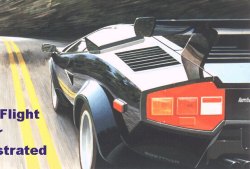

|
|
|
|
|
|
|
|
|
|
|
|
|
|
|
|
|
|
|
|
|
|
|
|
|
|
|
|
|
|
|
|
|
|
|
|
|
|
|
|
|
|
|
|
|
|
|
|
|
|
|
|
|
|
|
|
|
|
|
|
|
|
|
|
|
|
|
|
|
|
|
|
|
|
|
|
|
|
|
|
|
|
|
|
|
|
|
|
| Note
:
* Car & Driver's acceleration test was made on a US version Countach, while the top speed came from a European model. ** US version Countach had 420 hp instead of 455 hp. *** Road & Track's 173 mph was recorded in an oval track, this could lose a few mph. |
Firstly, as pointed out by Peter Dron in the book "Lamborghini Countach - The Complete Story", Countach's engine particularly needed more mileage to run-in than normal cars, otherwise the engine would be tight and unable to develop full potential. Peter Dron himself made the test for Fast Lane, in a Countach that regularly ran to top speed by owner Pierluigi Martini (the ex-F1 driver). No wonder the data recorded was by far better than other magazines. On the contrary, Autocar's tests were always the earliest in the English world, this could be one of its advantages, but inevitably picked a relatively new Countach for test.
Secondly, Lamborghini's production tolerance was also in questioned, at least in prior to the Diablo era. According to Lamborghini's own statement, some 5000QV engines produced 470 hp on test dynamometers, compared with the official figure 455 hp. If we apply that to a negative direction, we can say some engines might produced only 440 hp.
Thirdly, as mentioned before, the rear wing had decisive influence to top speed. With the wing, Car & Driver measured 166 mph in an European spec. QV (unlike the acceleration which was measured in a US version), very much lower than Autocar's 178 mph, let alone the controversial 190 mph that recorded by Fast Lane.
Fourthly, the test method is also arguable. Motor and Car & Driver used to conduct the acceleration test by racing-style launch, that is, winded the engine up to red line, than released the clutch as sharply as possible. Not only for this car, they did the same for every car they tested. Now you know why C&D always produced far better result than R&T, while Motor did better than Autocar. We cannot determine which one is RIGHT, but I can tell you most other mainstream magazines did the same as Autocar and R&T, such as Auto, Motor und Sport (the largest car magazine in Europe). We'd better to follow the majority's choice.
The 190 mph top speed recorded by Fast Lane was very unbelievable. For some reasons, Peter Dron measured it by a controversial method - the Italy's Autostrada highway has a "Kilometer Post" between every kilometer, he travelled at top speed in the Countach's passenger seat, pressed the stop watch in his hand when the car was passing a post, then press again at the next post, and the speed could be calculated by dividing the distance travelled by the time took ! Measured again in the opposite direction and he got the two-way top speed average of 190.1 mph !! Obviously, we cannot trust this human-dependable test method, especially when his data was so much faster than others had ever recorded. Anyway, the acceleration figure was recorded with the fifth wheel and calibrated electronic recorder so that it is fully trustable. It seems that the acceleration result alone could prove that his Countach must be in particularly good condition.